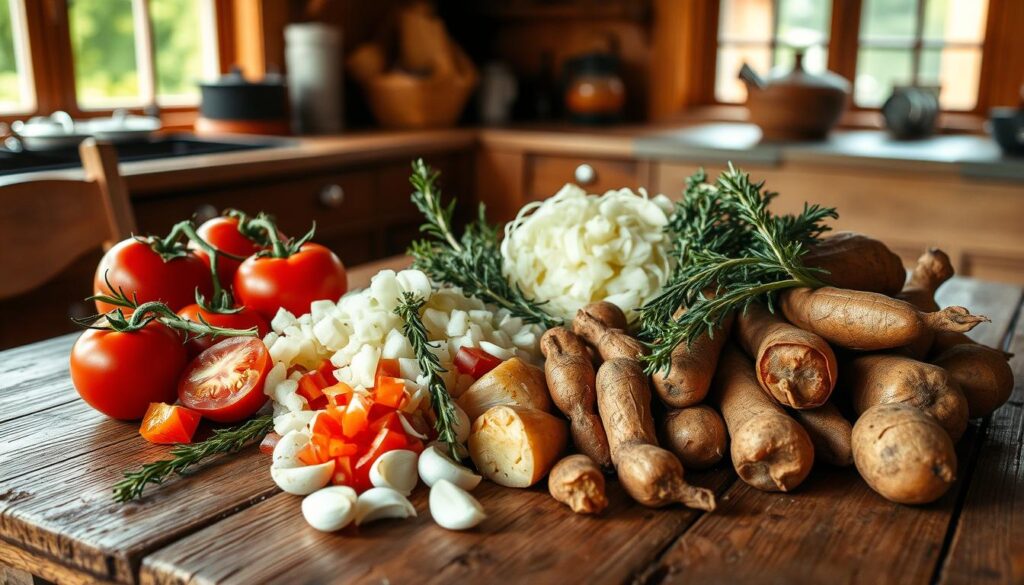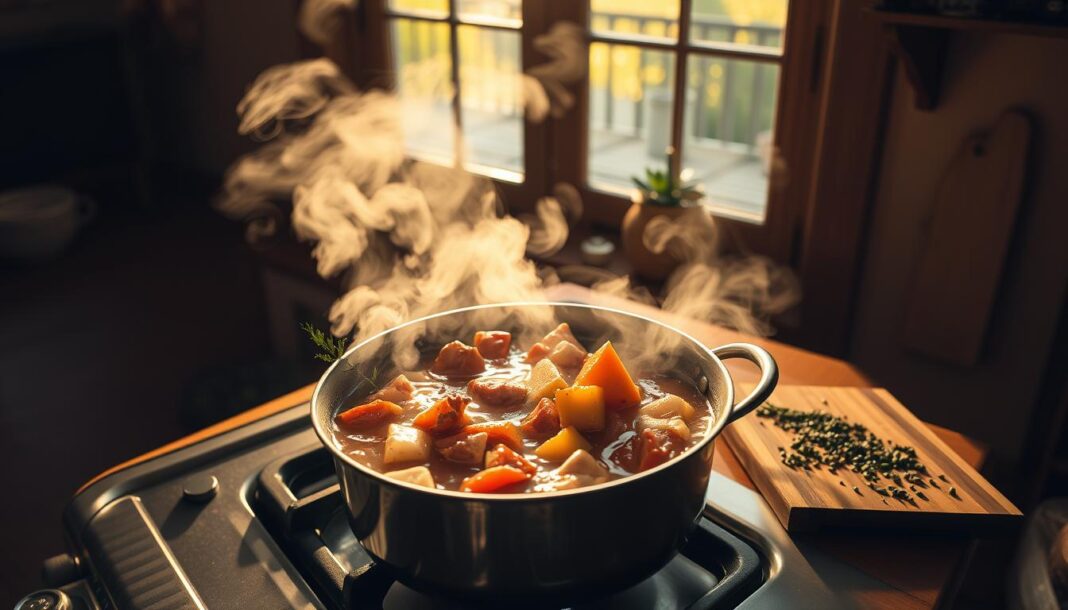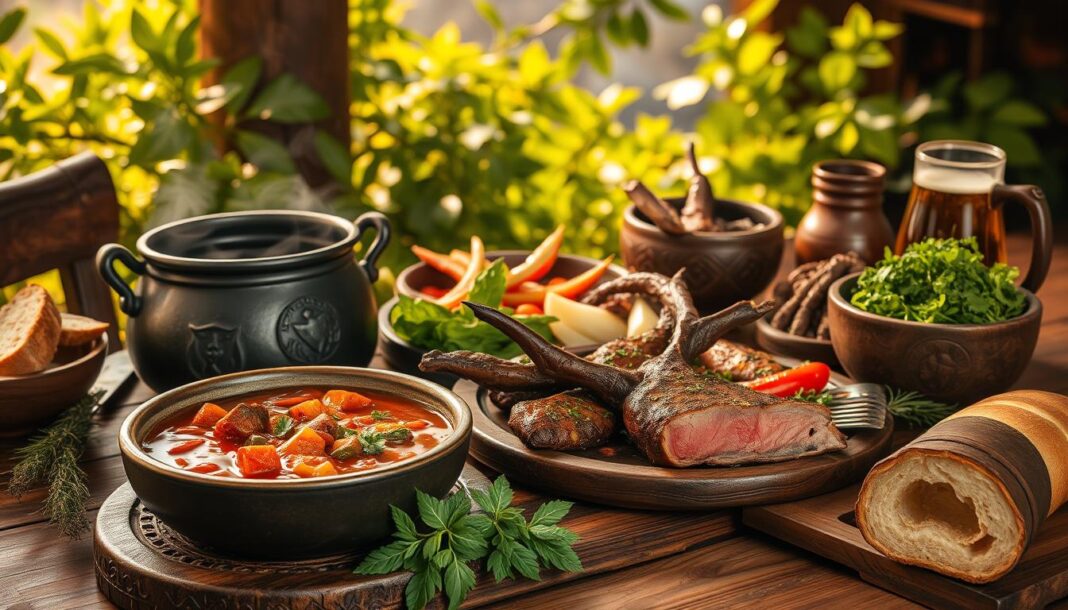Imagine a hearty, creamy stew that’s been inspired by the fictional world of Westeros from George R.R. Martin’s “Song of Fire and Ice” series. Our Sisters Stew recipe brings this fantasy to life, combining leeks, carrots, barley, and turnips with clams, cod, and crabmeat in a rich stock of heavy cream and butter.
This dish is more than just a recipe; it’s a cultural exploration and culinary adventure that blends historical cooking techniques with literary inspiration. At Historical Foods, we’ve meticulously tested and refined this stew to balance historical accuracy with modern cooking methods.
Whether you’re a fan of the “Game of Thrones” series or simply a lover of rich, seafood dishes, this guide will walk you through creating an authentic Sisters Stew, from understanding its origins to mastering the final presentation.
Key Takeaways
- Learn how to create an authentic Sisters Stew inspired by George R.R. Martin’s work.
- Understand the historical and cultural context behind this unique seafood dish.
- Discover the ingredients and cooking techniques required for this recipe.
- Master the preparation and presentation of this hearty, creamy stew.
- Explore the intersection of fictional food lore and traditional cooking methods.
The Origins of Sisters Stew
In exploring the history of Sisters Stew, we uncover its ties to the indigenous farming technique known as the ‘three sisters’ method. This traditional Native American practice involves planting corn, beans, and squash together, which not only enhances their growth but also forms the basis of a nutritious and flavorful stew.
A Taste of Westeros: The Literary Inspiration
While Sisters Stew may evoke the fantasy world of Westeros from Game of Thrones, its roots are firmly planted in Native American culinary traditions. The ‘three sisters’ – beans, corn, and squash – are staples in many Native American dishes, reflecting a deep understanding of companion planting and nutritional balance.
Historical Seafood Stews and Their Influence
Sisters Stew also draws inspiration from historical seafood stews found in maritime cultures. These stews typically combined local seafood with available vegetables and dairy, creating hearty meals for coastal communities. The creamy base of Sisters Stew bears resemblance to New England clam chowder, while its mixture of seafood varieties echoes Mediterranean cioppino and French bouillabaisse
Essential Ingredients for an Authentic Sisters Stew
Creating an authentic Sisters Stew requires a deep understanding of its essential ingredients. The dish, inspired by the rich culinary traditions found in the world of Westeros, relies on a harmonious balance of seafood, vegetables, and a creamy foundation to achieve its signature flavor and texture.
The Seafood Base: Cod, Crabmeat, and Clams
The seafood base of Sisters Stew is a medley of cod, crabmeat, and clams, providing a diverse and rich flavor profile. Freshness is key when selecting these ingredients to ensure the best taste. We recommend using the freshest catch available, as it directly impacts the overall quality of the stew.
Vegetables and Aromatics
Vegetables and aromatics play a crucial role in enhancing the depth of the stew. Onions, garlic, and celery are sautéed to create a flavorful base. The choice of vegetables can be adjusted based on personal preference, but these aromatics are essential for building the stew’s foundation.
The Creamy Foundation: Stock, Butter, and Cream
The creamy foundation is what sets Sisters Stew apart, making it a luxurious and comforting dish. We use 3 cups of fish stock, made by simmering fish heads, vegetables, herbs, and white wine for 30 minutes, as the base. To enrich the stew, 1 cup of heavy cream is warmed gently and added along with 1/4 cup (1/2 stick) of unsalted butter. The stew is then cooked for an additional 5 minutes until the fish is cooked through and the butter is melted, seasoned with salt and pepper to taste.

The balance between stock, cream, and butter is crucial. It requires careful attention to achieve the perfect consistency—rich and satisfying without becoming overly heavy or greasy. This balance is what makes Sisters Stew a truly decadent experience.
Preparing Sisters Stew: A Step-by-Step Process
Now that we have our ingredients ready, let’s dive into the step-by-step process of preparing Sisters Stew. This dish, inspired by the flavors of Westeros, requires careful attention to detail and a bit of patience.
Creating a Flavorful Base
The foundation of a great Sisters Stew lies in its flavorful base. We start by sautéing a mix of vegetables and aromatics, including a hint of cumin for added depth. This step is crucial as it sets the tone for the entire dish. By cooking the vegetables until they are just tender, we ensure that they retain their texture while infusing the stew with their flavors.
Adding Vegetables and Barley
Next, we add the vegetables and barley to the pot, stirring well to combine. This is where the stew starts to take shape, and the barley begins to absorb the rich flavors of the broth. It’s essential to monitor the heat and adjust as necessary to prevent the barley from becoming too mushy or the stew from boiling over.
Incorporating Seafood and Finishing Touches
The final phase of preparing Sisters Stew involves adding the seafood and finishing touches. We start by adding cod and simmering it for 5-10 minutes until it’s almost cooked. Then, we warm cloves-infused cream gently with saffron and nutmeg before stirring it into the stew. Finally, we add crabmeat and clams, cooking for another 5 minutes until the seafood is done. The stew is then seasoned with salt and pepper to taste. To finish, we garnish with a sprinkle of fresh cilantro for a burst of freshness.
As we guide you through the delicate final phase of preparing Sisters Stew, it’s clear that timing and temperature control are critical. Here are some key points to keep in mind:
- Seafood requires careful handling to prevent overcooking. Adding each type at the precise moment ensures optimal texture and flavor.
- The addition of cream transforms the consistency of the stew. Gentle heat is necessary to prevent curdling while allowing the flavors to harmonize.
- Subtle finishing touches, including spices like saffron and nutmeg, elevate the dish from good to exceptional.
- Final seasoning adjustments with salt and pepper are made at this stage, as the full flavor profile has developed and can be properly balanced.

Serving Suggestions and Final Tips for Your Sisters Stew
As we conclude our journey through the rich history and preparation of Sisters Stew, we’re excited to share how to serve this delightful dish. Sisters Stew can be served hot with plenty of freshly ground pepper and black bread, or in hollowed-out large rolls or small bread loaves for an authentic touch.
For a more elaborate meal, consider pairing it with a side salad or half sandwich. The Three Sisters Stew variation, featuring squash, beans, and corn, is hearty enough to be a meal on its own, often served with fresh bread like Indian fry bread or cornbread.
To enhance your dining experience, you can also serve the stew in a trencher—a hollowed-out bread loaf—for a spectacular presentation. Feel free to get creative with ingredient substitutions based on seasonal availability, such as using butternut squash or adjusting the amount of corn. With these final tips, you’re ready to enjoy your delicious Sisters Stew.


